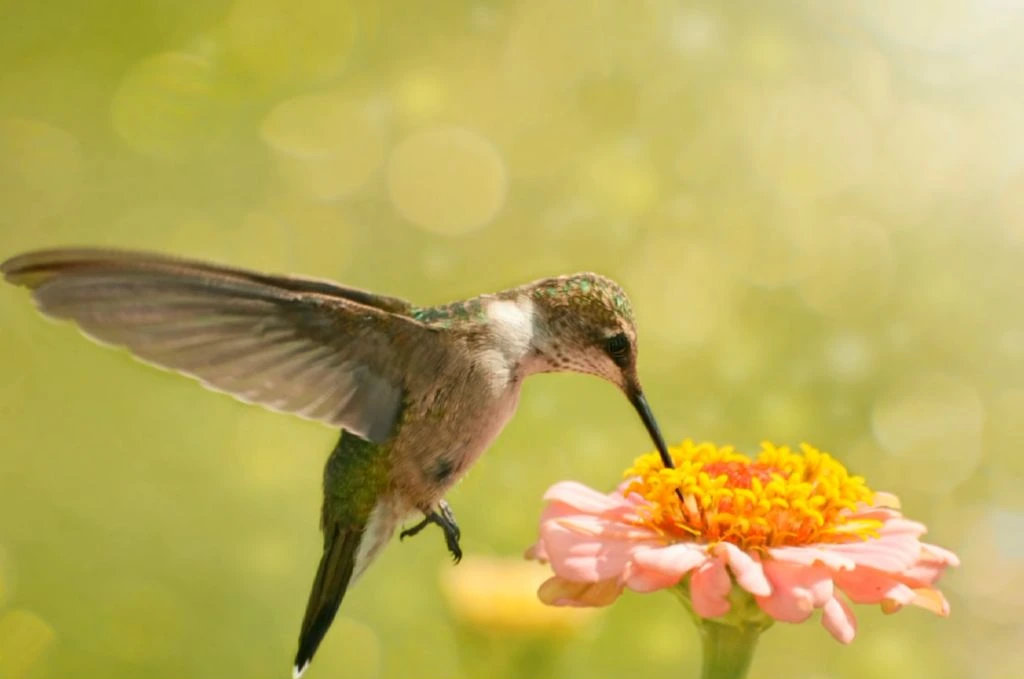Since we rarely see them as anything other than hanging flowers, it is easy to assume that all hummingbirds are the same. But they live in different geographical regions and have different temperaments. Nesting preferences and colors are also included.
Hummingbirds are known to be found within specific ranges, whether as year-round residents or as part of a migratory cycle. Some hummingbird species are year-round residents of California; others are uncommon. They appear at feeders far beyond their known range. These hummingbirds are known as “vagrants” in the world of ornithology.
1. Anna’s Hummingbird
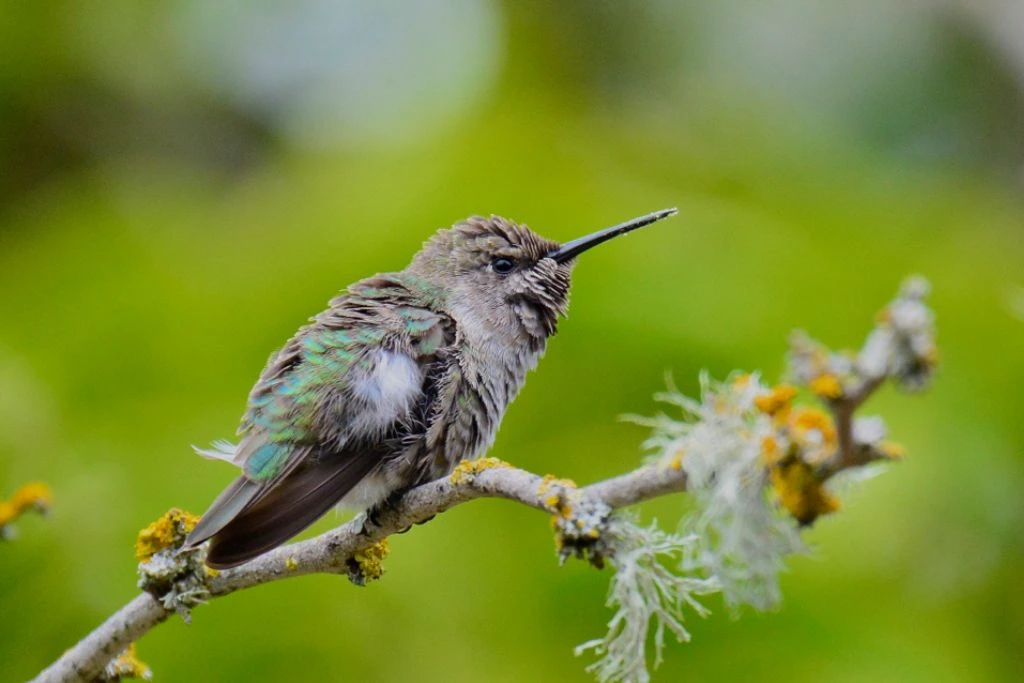
- Kingdom: Animalia
- Phylum: Chordata
- Class: Aves
- Order: Apodiformes
- Genus: Calypte
- Species: Calypte anna
- Length: 3.9 – 4.3 in (9.9 – 10.9 cm)
- Weight: 0.1 – 0.2 oz (2.8 – 5.7 g)
- Wingspan: 4.7 in (12 cm)
In California, Anna’s hummingbirds are prevalent and listed on 40% of state checklists. After breeding, some of Anna’s Hummingbirds in Northern California might travel a short distance.
Their chest and belly are covered in emerald feathers, and their green feathers are brighter and much more lustrous than most others. The multicolored feathers on the males’ heads reach up onto their foreheads, and they have rosy-pink necks.
Although they can also be found in scrub and savannah, Anna’s hummingbirds prefer backyards and parks. It aligns with their enormous, vibrant blooms and nectar feeders. The nests of Anna’s hummingbirds are located high in trees, between 6 and 20 feet up, and they have two to three broods per year. They are year-round residents of most of California but are less frequent in Death Valley and the Mojave Preserve.
2. Allen’s Hummingbird
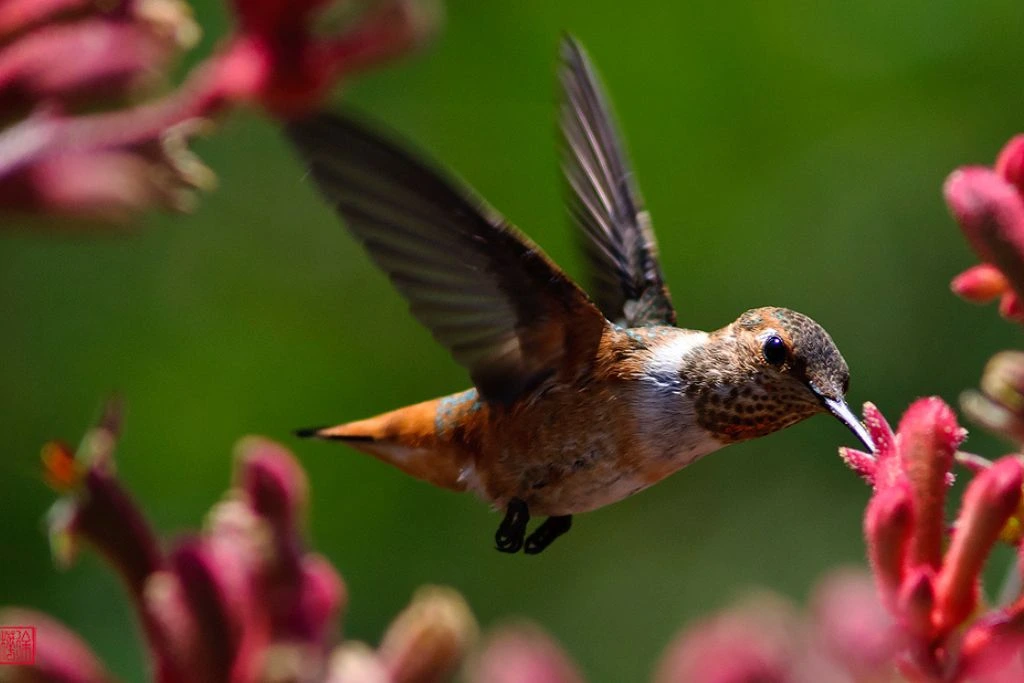
- Kingdom: Animalia
- Phylum: Chordata
- Class: Aves
- Order: Apodiformes
- Genus: Selasphorus
- Species: Selasphorus sasin
- Length: 3.5 in (9 cm)
- Weight: 0.1-0.1 oz (2-4 g)
- Wingspan: 4.3 in (11 cm)
Allen’s hummingbirds are plentiful in California in the summertime. Some come as early as January, as farther north as San Francisco. Most of Allen’s hummingbirds from Northern California have moved south by September. Allen’s hummingbirds move up toward the Pacific Coast in California and Oregon as early as January and spend the winter in Mexico. Some live through the winter in Central Mexico and the Los Angeles area.
Allen’s hummingbird females and young males have slender, outer tail feathers, and the males have solid green backs.
They can have up to three broods a year and construct nests at no particular height along shady streams.
3. Black-chinned Hummingbird
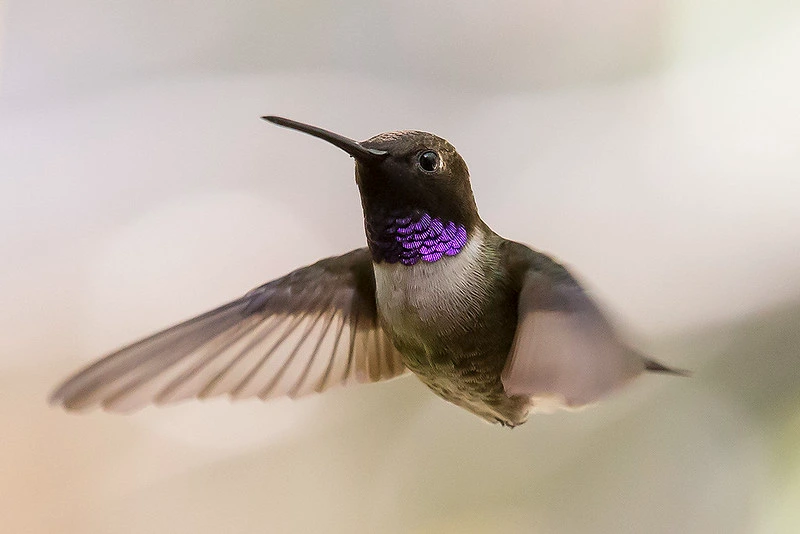
- Kingdom: Animalia
- Phylum: Chordata
- Class: Aves
- Order: Apodiformes
- Genus: Archilochus
- Species: Archilochus alexandri
- Length: 3.5 in (9 cm)
- Weight: 0.1-0.2 oz (2.3-4.9 g)
- Wingspan: 4.3 in (11 cm)
In the rest of the state, black-chinned hummingbirds are more spotted during migrations. They breed along the coast of California. They can be discovered among shady oaks on the Gulf Coast or by canyons and rivers in the Southwest.
Black-chinned hummingbirds have grayish-white undersides and dull, metallic green backs. The ladies have a pale throat with white tail feather tips, while the males have a black throat with a thin, iridescent purple foundation.
They consume nectar, tiny insects, and spiders. When consuming nectar, their tongues can lick 13 to 17 times per second. Black-chinned hummingbirds lay two white, little eggs only 0.6 inches in diameter. They return to a favorite perch, and they are at the tops of dead trees on tiny, bare limbs.
4. Costa’s Hummingbird
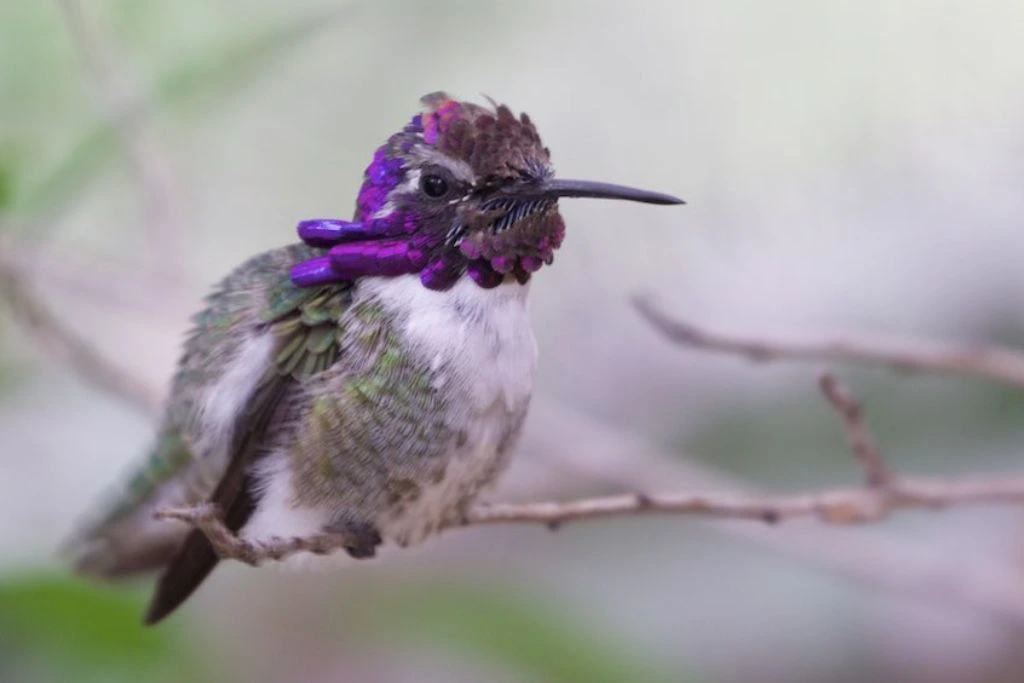
- Kingdom: Animalia
- Phylum: Chordata
- Class: Aves
- Order: Apodiformes
- Genus: Calypte
- Species: Calypte Costae
- Length: 3–3.5 in (7.6–8.9 cm)
- Weight: 3.05 g for males and 3.22 g for females
- Wingspan: 4.3 in (11 cm)
Costa’s hummingbirds are desert-dwelling hummingbirds with eye-catching, outward-curving purple neck patches and crowns. Their stomachs are white and green, coloring on the sides, and their backs are green. Female Costa hummingbirds have a white belly and lack the purple tint.
Baja California, Southern California, and Southwestern Arizona are home to Costa’s hummingbirds. They travel from Mexico’s Pacific coast to Arizona throughout the winter to breed. Costa’s hummingbirds live in desert scrub, scrubland, and frequent various plant types.
They can have the largest of two broods a year and build their nests in shrubs between three and seven feet off the ground.
5. Rufous Hummingbird
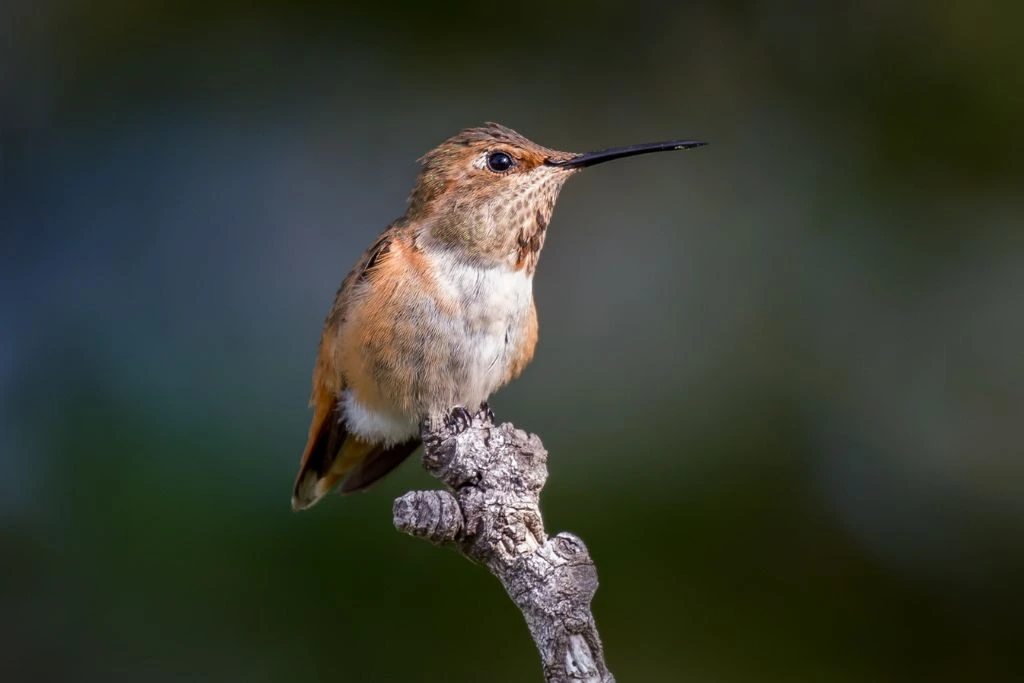
- Kingdom: Animalia
- Phylum: Chordata
- Class: Aves
- Order: Apodiformes
- Genus: Selasphorus
- Species: Selasphorus rufus
- Length: 2.8-3.5 in (7-9 cm)
- Weight: 0.1-0.2 oz (2-5 g)
- Wingspan: 4.3 in (11 cm)
Although they can start migrating as early as January, Rufous hummingbirds come through California around mid-February and May. Allen’s Hummingbirds will only stay around for a short time during migration.
They have a white patch below the throat, a brilliant orange back and belly and, in the case of the males, an iridescent red throat. The females have a whitish belly and a back that is greenish-brown and rusty in color. They resemble Allen’s hummingbirds in appearance quite a bit.
The main food sources for Rufous hummingbirds are nectar from vibrant tubular flowers and insects. They use silky plant down and spider webs to keep their nest together as they construct it high up in the trees. They are quite hostile and chase away any other hummingbirds that may approach them.
6. Calliope Hummingbird
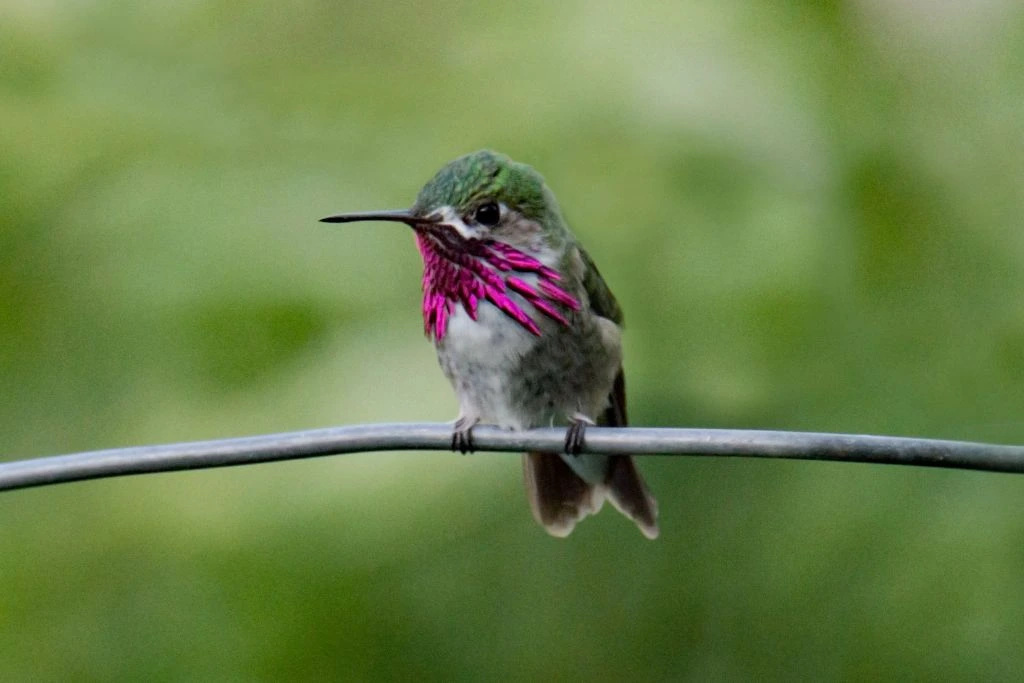
- Kingdom: Animalia
- Phylum: Chordata
- Class: Aves
- Order: Apodiformes
- Genus: Selasphorus
- Species: Selasphorus calliope
- Length: 3.1-3.5 in (8-9 cm)
- Weight: 0.1-0.1 oz (2.3-3.4 g)
- Wingspan: 4.1-4.3 in (10.5-11 cm)
In most of California, Calliope hummingbirds are most spotted during migration. They have breeding grounds in Northern California, Sierra Nevada and, in certain cases, San Francisco. The Calliope Hummingbird, the tiniest bird in America, travels over 5000 miles from Mexico to Canada and back. They fight to defend their turf and even pursue red-tailed hawks.
The gorget, a vivid magenta throat, glossy green backs and sides, and a dark tail are all characteristics of Calliope hummingbird males. The underside of females is more pinkish-white than white, unlike that of males, who have iridescent throats.
Nests may be reused or built over an older nest found on evergreen trees. The Rocky Mountains are used during the fall migration to the wintering sites in Southwest Mexico.
7. Broad-Billed Hummingbird
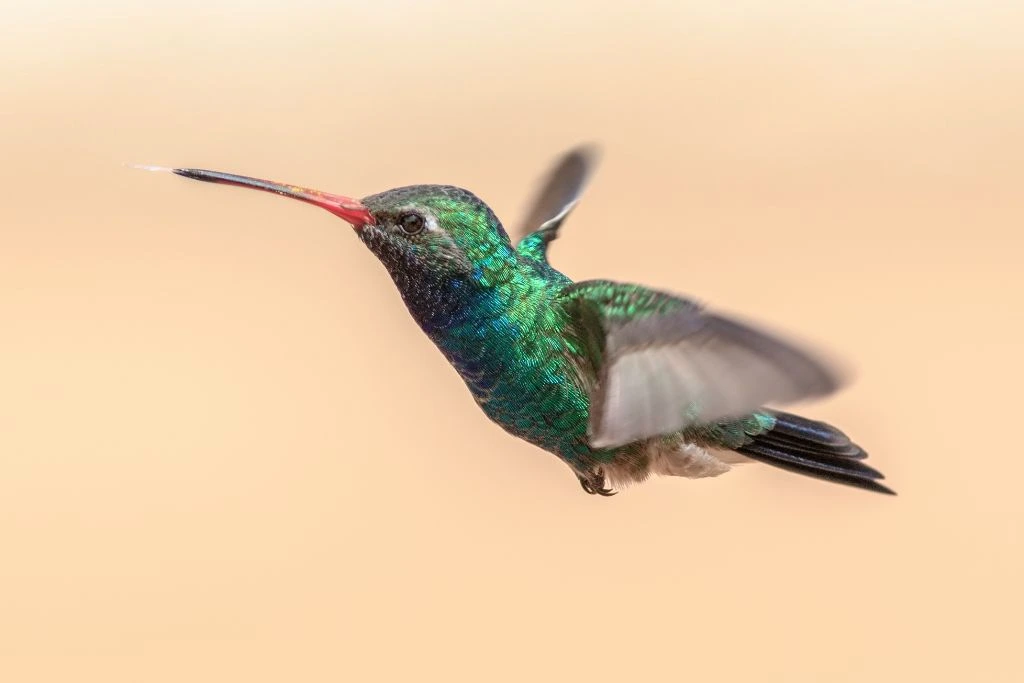
- Kingdom: Animalia
- Phylum: Chordata
- Class: Aves
- Order: Apodiformes
- Genus: Cynanthus
- Species: Cynanthus latirostris
- Length: 3.1 – 3.9 in (8-10 cm)
- Weight: 0.1-0.1 oz (3-4 g)
Even among hummingbirds, broad-billed hummingbirds have striking colors. The males have a deep metallic green color throughout, and their blue throats reach down to their breasts. Males and females both have red beaks that are wide toward their heads and have black tips.
They are year-round residents of Central Mexico and the Pacific Coast of Mexico. Some birds spend the entire year close to the Mexican border, while others travel north to breed in Southern Arizona and New Mexico mountain valleys. Broad-billed hummingbirds prefer to forage in canyon streams but will also visit garden feeders. Near streams, nests are constructed at a low height of 3 feet.
8. Broad-Tailed Hummingbird
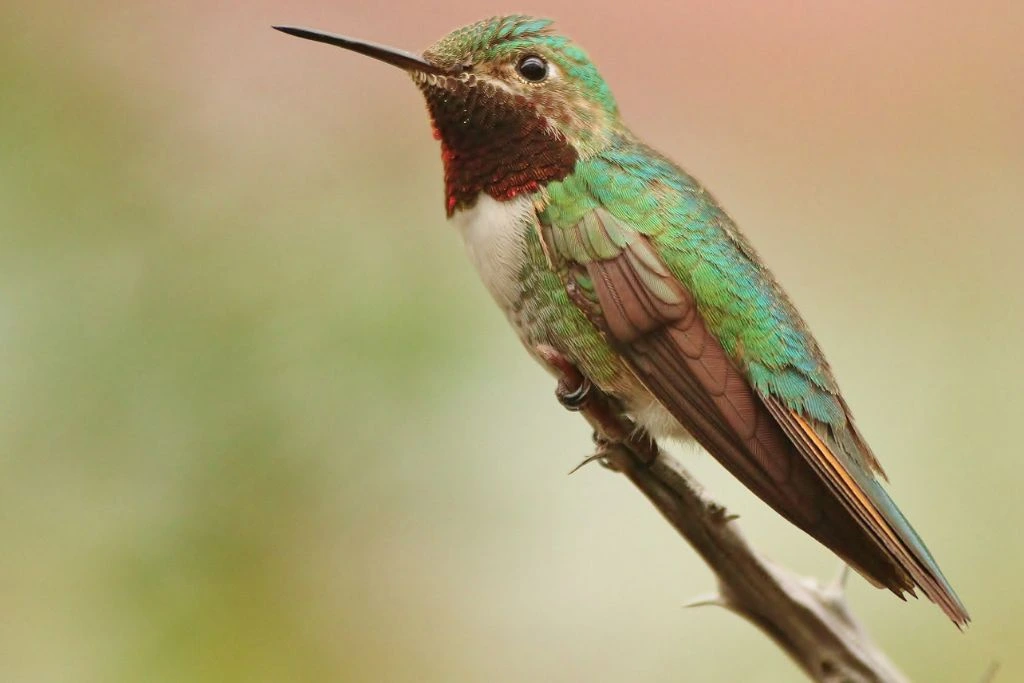
- Kingdom: Animalia
- Phylum: Chordata
- Class: Aves
- Order: Apodiformes
- Genus: Selasphorus
- Species: Selasphorus platycerus
- Length: 3.1-3.5 in (8-9 cm)
- Weight: 0.1-0.2 oz (2.8-4.5 g)
Higher heights are home to broad-tailed hummingbirds with iridescent green backs. Females and youngsters have green dots on their cheeks and throats, while males have iridescent pink throats.
These hummingbirds breed in high meadows and open forests between 5,000 and 10,000 feet before moving to Southern Mexico for the winter.
The Broad-tailed Hummingbird may slow their heart rate and lower their body temperature. They will visit hummingbird feeders and drink from roselle and scarlet gilia. They eat small insects to enhance their food and feed insects to their young. Broad-tailed Hummingbird nests are lined with gossamer and spider webs to provide extra warmth.
9. Green-Violetears Hummingbird
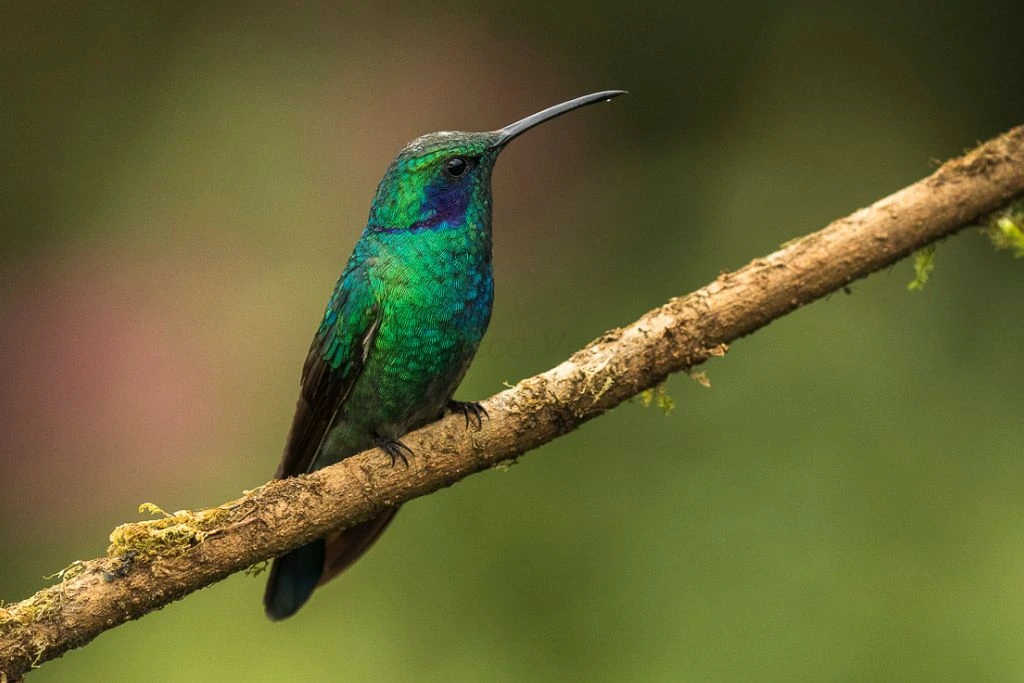
- Kingdom: Animalia
- Phylum: Chordata
- Class: Aves
- Order: Apodiformes
- Genus: Colibri
- Species: Colibri Thalassinus
- Length: 9.7 to 12 cm (3.8 to 4.7 in)
- Weight: 4.8 to 5.6 g (0.17 to 0.20 oz)
The green-violetear hummingbird has vivid violet ear spots on the sides of its neck and is an iridescent green hummingbird. This hummingbird’s tail is metallic blue-green, and its center tail feathers are golden, with a black band beneath them.
From Mexico to Nicaragua, these hummingbird species can be found near the edges of cloud forests. It is where they thrive in an environment with a lot of tropical humidity. Individual birds have wandered as far north as Wisconsin, Michigan, and Canada. Mexican-violetears are present in Texas.
This black hummingbird travels between mountain ranges and in woodland edges and clearings. They are a single nester, like many other hummingbird species. These hummingbirds hunt for nectar and insects alone rather than in a group.
10. Violet-Crowned Hummingbird
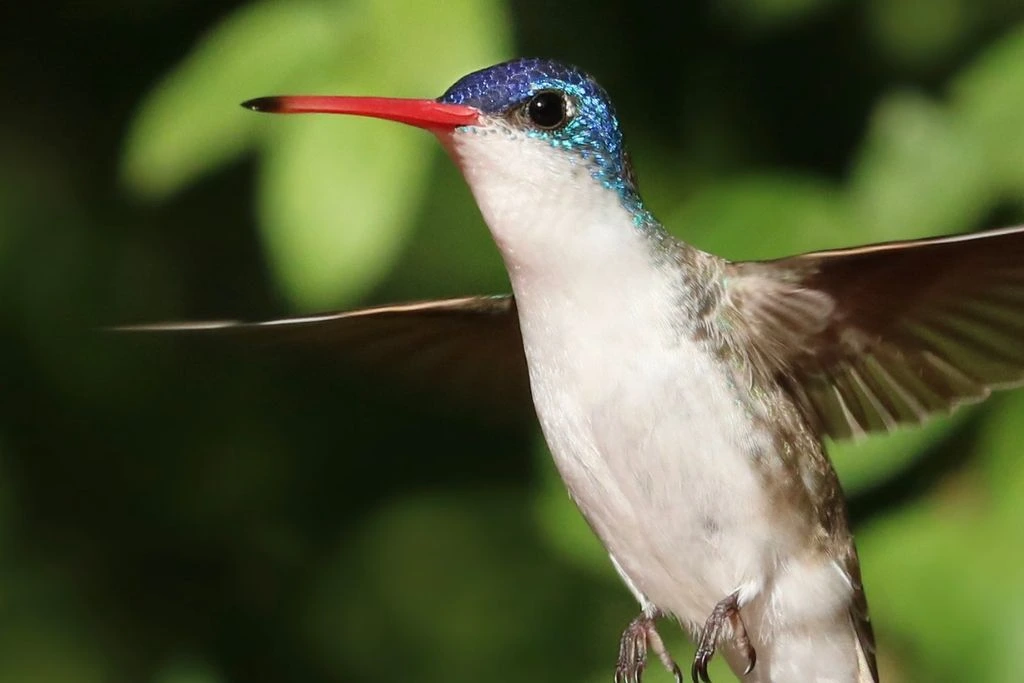
- Kingdom: Animalia
- Phylum: Chordata
- Class: Aves
- Order: Apodiformes
- Genus: Ramosomyia
- Species: Ramosomyia voliceps
- Length: 4 in (10 cm)
- Weight: 0.18 oz (5 g)
A hummingbird species known as the violet-crowned belongs to the vagrant group since it migrates into California. The riparian habitat that violet-crowned hummingbirds like can be found in forest regions close to rivers. They have also been seen in California, hanging out at hummingbird feeders. They are picky about their nesting grounds and only lay their eggs in Arizona sycamore trees. As they migrate farther north, more hummingbirds spend the winter in the Southern United States.
They get their name first from the brilliant purple feather crown that covers their heads. These hummingbirds have a length of 3 to 3.9 inches. The reddish-orange beak of male violet-crowned hummingbirds has a black mark at the tip. Their topsides are olive green, and their belly is a distinct bright white color, extending from the bottom of its beak to the entirety of their body.
11. Xantus’s Hummingbird
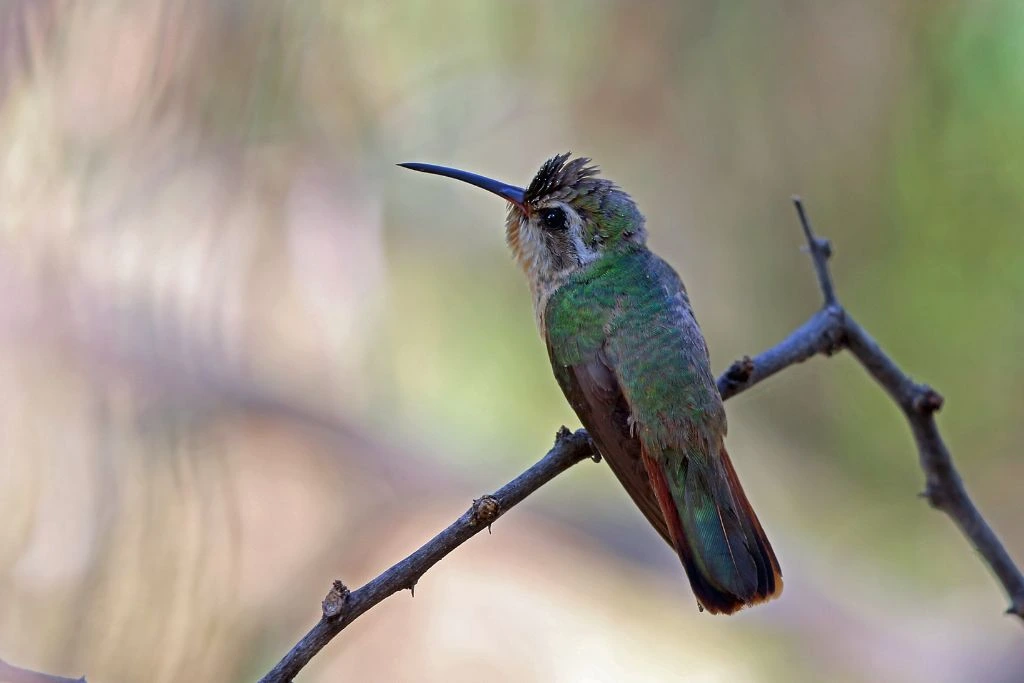
- Kingdom: Animalia
- Phylum: Chordata
- Class: Aves
- Order: Apodiformes
- Genus: Basilinna
- Species: Basilinna Xantusii
- Length: 8.5 to 9.5 cm (3.3 to 3.7 in)
- Weight: Male – 0.3-0.3 oz (8.1-8.6 g) Female – 3.4 g (0.12 oz)
The crown and gorget of the male Xantus hummingbirds are a dark, iridescent green color that, depending on the lighting, can appear black. Adults have a dark reddish-brown tail with slight black ends, and their topsides are green. The conspicuous white band above the eye that runs down is the Xantus hummingbird’s most distinguishing feature. Both sexes have cinnamon-colored underbellies.
The Xantus hummingbird is found in Baja, California, yet it wanders into Southern California and the Pacific Coast as a “vagrant.” For birdwatchers in California, seeing a Xantus hummingbird in their yard is a rare pleasure because of this. Outside its regular Baja settings, stray Xantus hummingbirds travel much farther north. The only hummingbird native to or observed in Baja, California, is the Xantus.
12. Blue-Throated Hummingbird
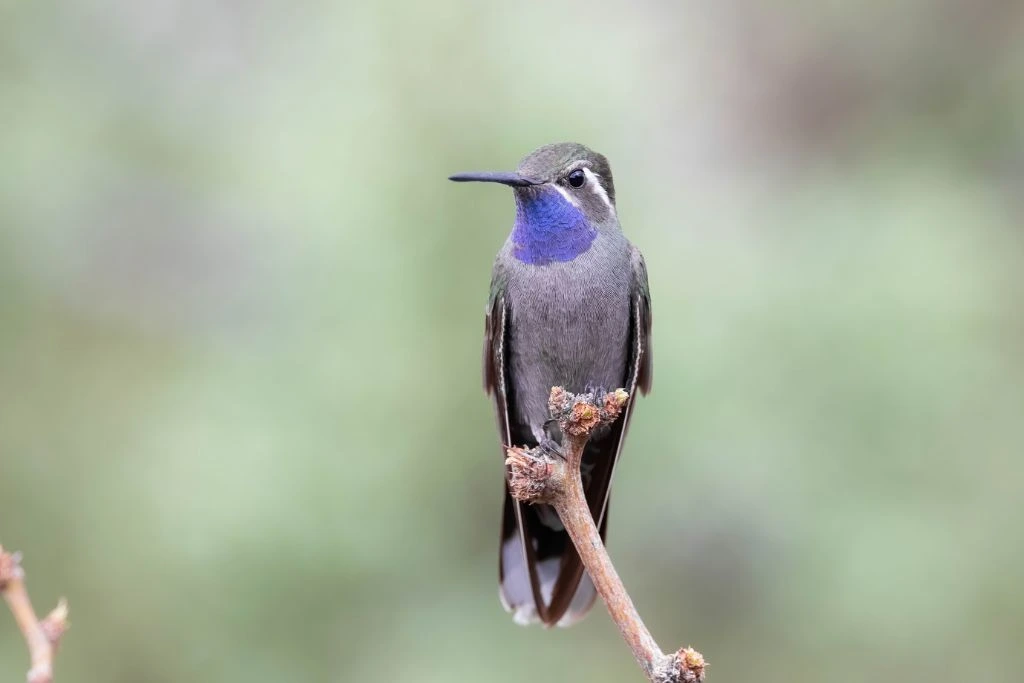
- Kingdom: Animalia
- Phylum: Chordata
- Class: Aves
- Order: Apodiformes
- Genus: Lampornis
- Species: Lampornis clemenciae
- Length: 4.3-4.7 in (11-12 cm)
- Weight: 0.3-0.3 oz (8.1-8.6 g)
A large hummingbird, the blue-throated hummingbird, is 4.5 to 4.9 inches long. In California, this hummingbird wanders around as a vagrant guest. They can also be found in the Texas and Arizonan mountain ranges.
A male blue-throated hummingbird has striking white stripes across both of its eyes.
Each year, they have been observed returning to the same nest and building more nests on top of older ones until the structure resembles a tall tower. Mountainous blue-throated hummingbirds like to build their nests on cliff faces.
Blue-throated hummingbirds become possessive of flower species with greater sugar content. Due to their size and energy requirements, they are insectivorous and consume more flies than any other hummingbird genus.
13. Rivoli’s Hummingbird
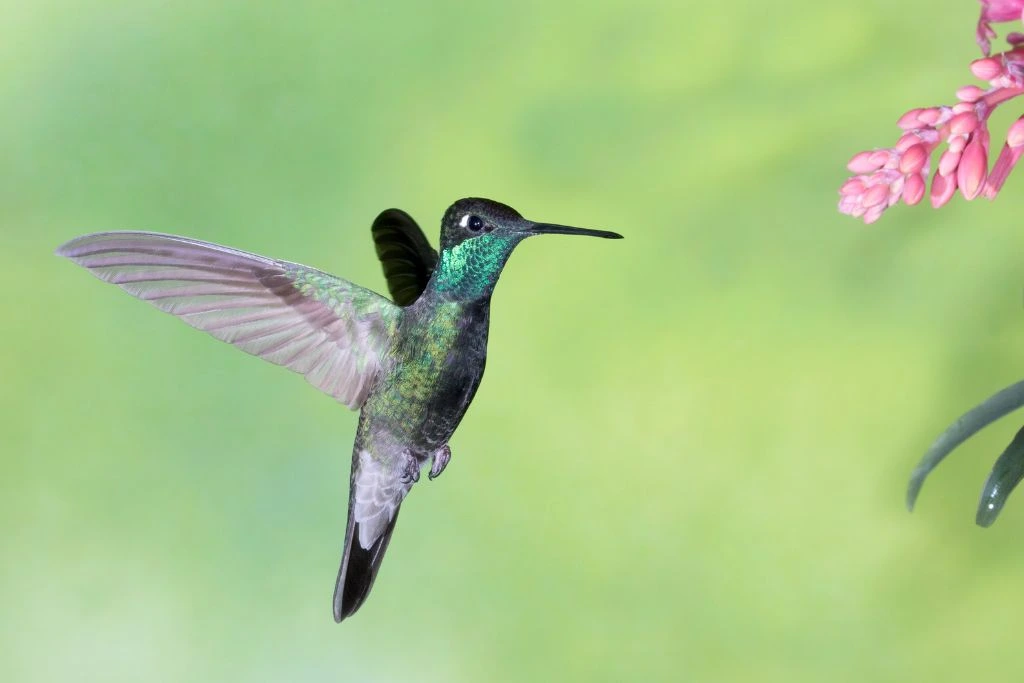
- Kingdom: Animalia
- Phylum: Chordata
- Class: Aves
- Order: Apodiformes
- Genus: Eugenes
- Species: Eugenes fulgens
- Length: 4.3–5.5 in (11–14 cm)
- Weight: 0.2–0.3 oz (7–8 g)
- Wingspan: 7.1 in (18 cm)
Rivoli’s hummingbirds are found in the mountains of Arizona, New Mexico, and Central America. In California, however, they prefer to live in ravines, feed in open meadows, and nest in trees that overhang streams and creeks. Rivoli’s hummingbirds have been observed hybridizing with other hummingbird species in the South.
Except in bright sunlight, these hummingbirds are somehow dark in color. They range in length from 4.3 to 5.5 inches.
Their heart rate ranges from 420 to 1,200 beats per minute, making them the record for the fastest heart rate of any living vertebrate.
14. Ruby-Throated Hummingbird
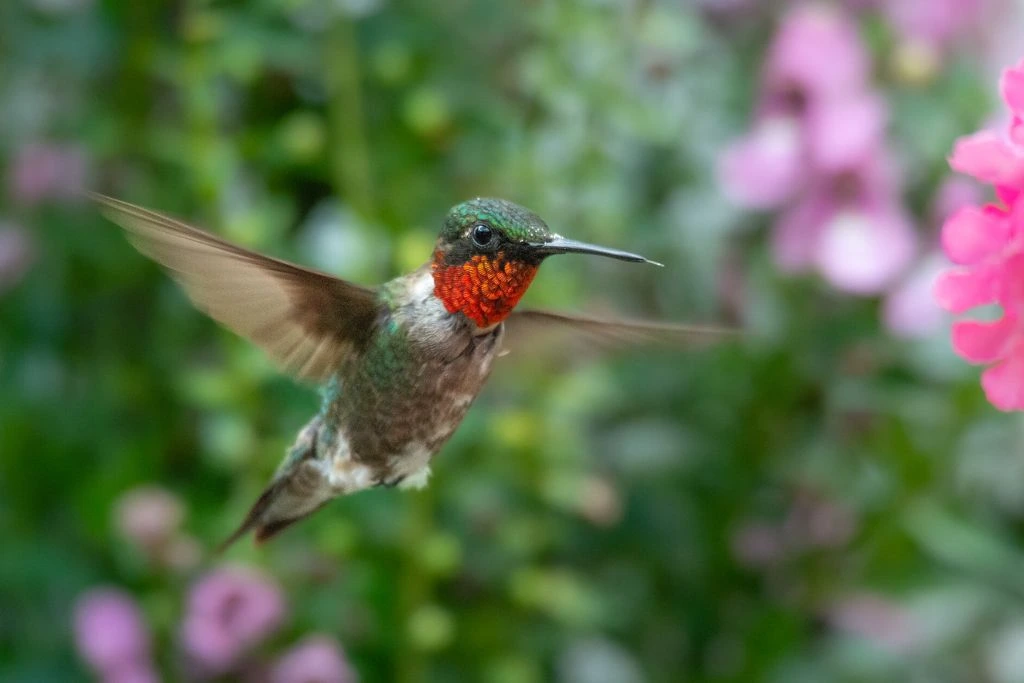
- Kingdom: Animalia
- Phylum: Chordata
- Class: Aves
- Order: Apodiformes
- Genus: Archilochus
- Species: Archilochus colubris
- Length: 2.8-3.5 in (7-9 cm)
- Weight: 0.1-0.2 oz (2-6 g)
- Wingspan: 3.1-4.3 in (8-11 cm)
Ruby-throated hummingbirds are common in the Eastern United States. These hummingbirds prefer small woodland, but they can also be found in parks, gardens, and backyards.
The ruby-throated hummingbird is a small species, measuring 2.8 to 3.3 inches. Male ruby-throated hummingbirds have ruby-colored gorgets and blander, metallic green surface facilities. Their life expectancy is about 5 years.
Except during mating season, they are solitary birds. Despite their aggressive nature, these hummingbirds can be eaten by predators. It includes large marine animals, praying mantises, orb-weaver tarantulas, and dragonflies.
Frequently Asked Questions
Are hummingbirds present in California all year?
Yes. While gardeners in colder climates must say goodbye to hummingbirds as they migrate South in the fall, some hummingbirds live in Southern California all year.
When are the best months to see hummingbirds in California?
Hummingbirds begin to arrive in California in late January. This spring migration will last until the end of June, when all hummingbirds migrating onward will have left California. California residents are fortunate to have Anna’s hummingbird, Allen’s hummingbird, and Calliope hummingbird that visit them all year.
How prevalent are hummingbirds in California?
Anna’s hummingbirds are common in California, appearing on 40% of state checklists. After breeding, some of Anna’s hummingbirds in Northern California could migrate a short distance. They are small green and gray birds.
Do hummingbirds return to the same yard year after year?
Yes. Most of these birds return to the same relays or gardens year after year to breed. Furthermore, they frequently stop at the same places along the way and start arriving on the same day.
Do hummingbirds migrate out of California in the winter?
No. While gardeners in colder climates must say goodbye to hummingbirds as they migrate South in the fall, some hummingbirds live in Southern California all year.
Why have hummingbirds stopped visiting feeders?
The availability of natural food sources or nesting sites has changed, prompting the birds to take a gander elsewhere. Hummingbirds can be killed or injured by free-roaming, domesticated animals, despite their small size and speed. According to some studies, a good wildflower crop decreases the number of hummingbird trips to feeders.
Conclusion
Hummingbirds are an attraction to behold in California. This state is home to a wide range of species, many of which are year-round inhabitants.
There are approximately eight distinct hummingbird species native to California, with at least 14 total species visible throughout the year.
Several rare hummingbird species can be found in the state, and some genetic morphs are frequently seen because of the broad range of genetic diversification.

